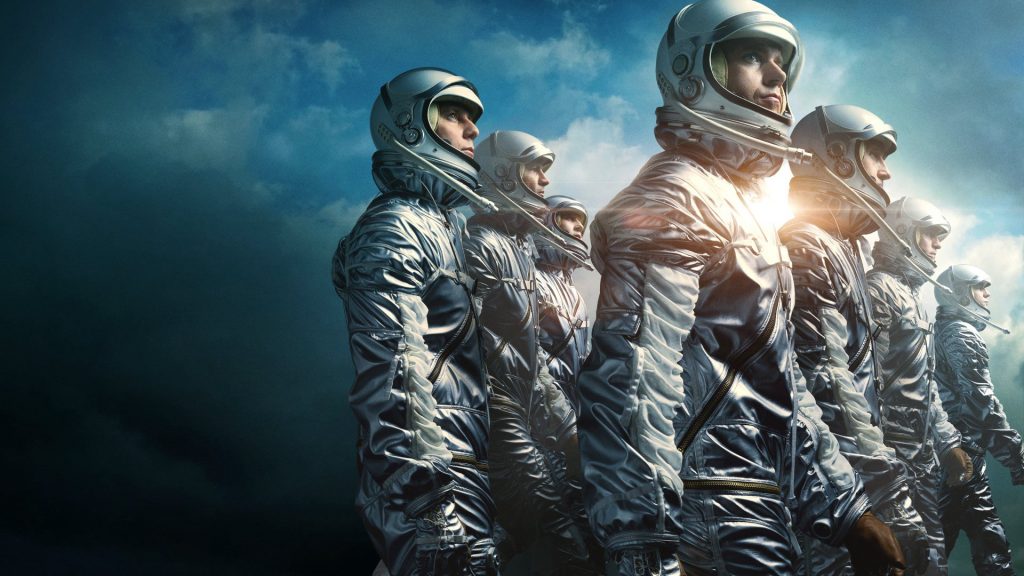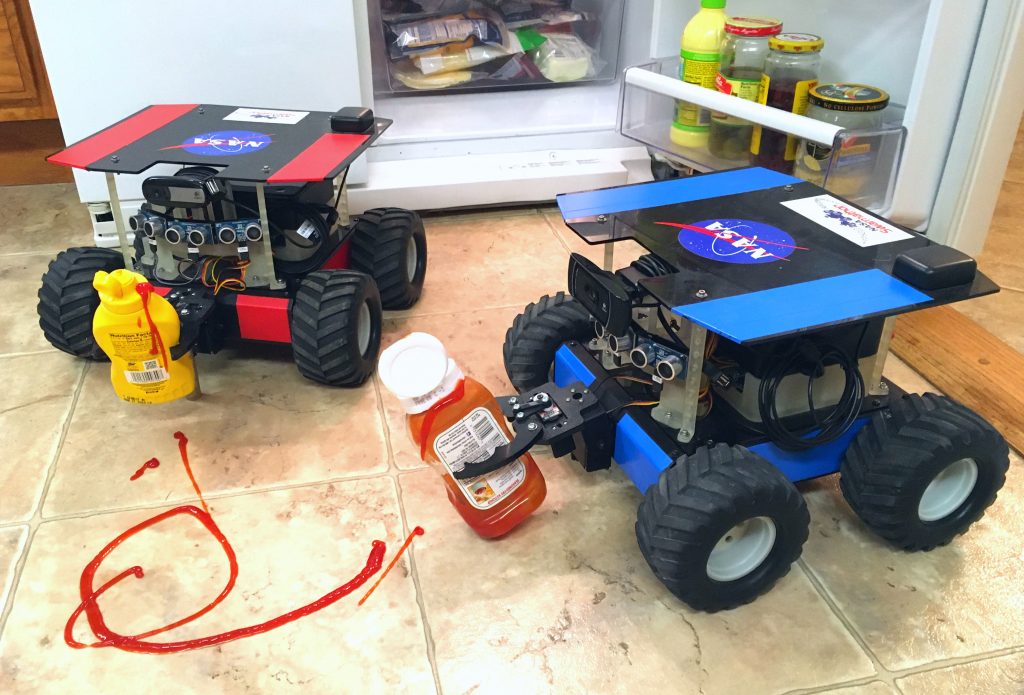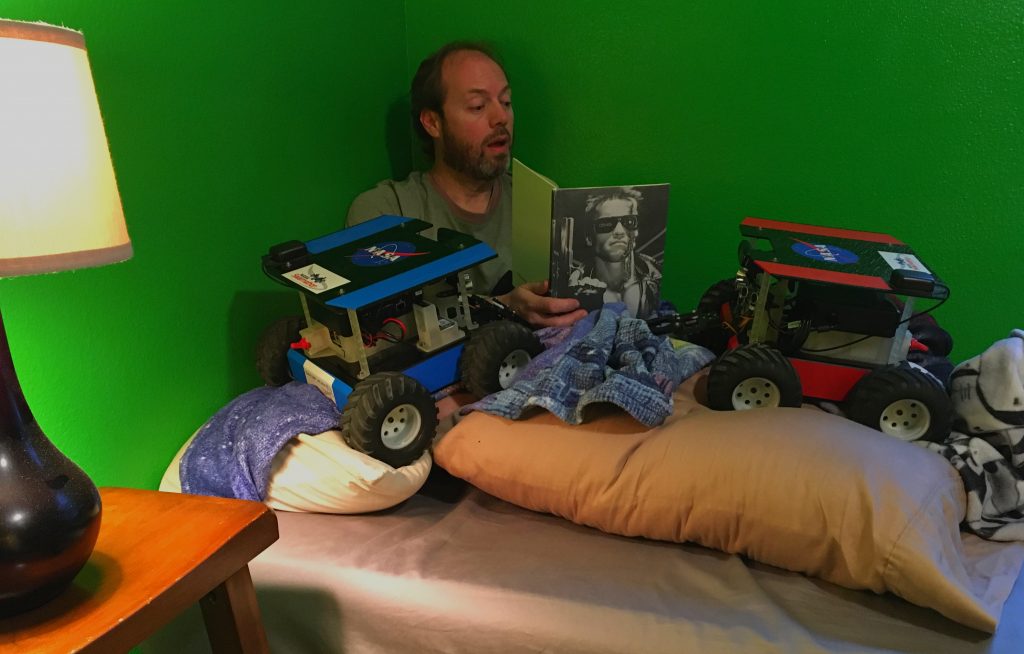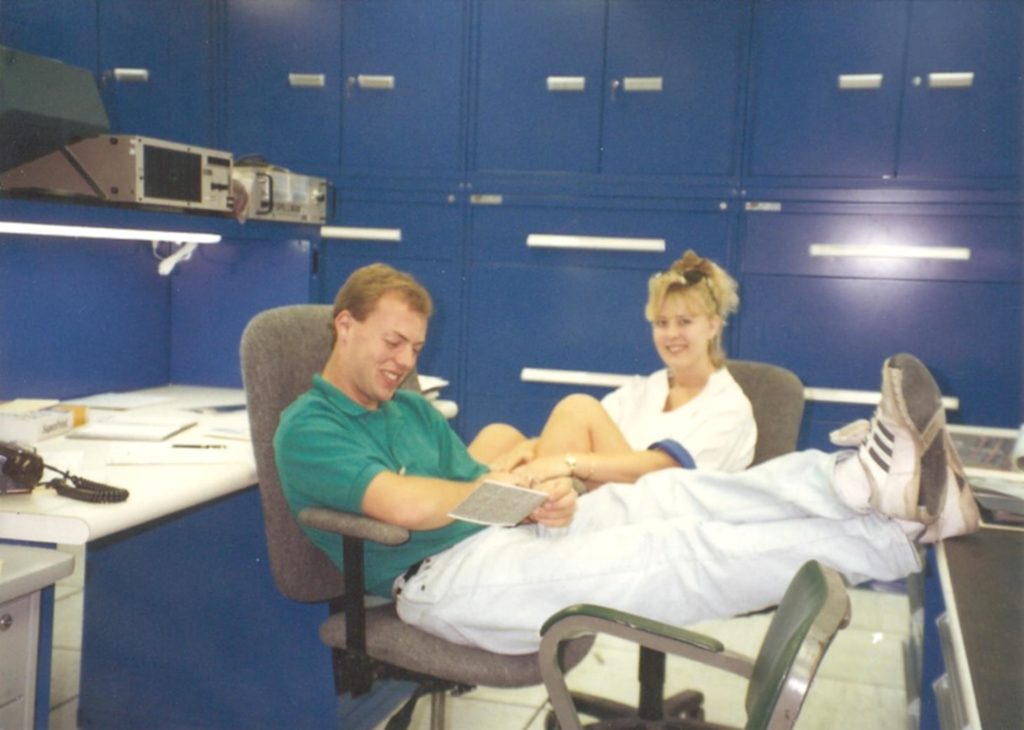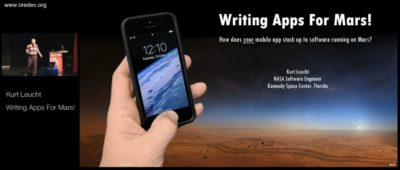During the summer of 1994, I had recently graduated from college with my Electrical Engineering degree and I was now working full time at NASA/KSC in Florida. That summer I was spending time with other groups at KSC in an effort to learn more about the entire KSC organization. I was also working on a special project for my own group.
Here are the statuses that I submitted each week to let my boss know what I was doing and how I was doing. It’s kinda fun to look back 25 years and remember exactly what I was doing back then.
June 16, 1994
When I came to work on Monday, my supervisor, Gary Bassett explained to me what he wanted me to work on. He needed me to put all my efforts, at least initially, into getting our video lab back in working order. The new video-computer system has been in place for almost a year and has been very intermittent and unreliable since its initial installation. The system has many different components that need to work together, instead they seem to be fighting each other all the time.
I got the video-computer system’s ATVista card working so we could take photographs of the fathers and sons that came through the labs during KSC Son’s Day, which was Tuesday. I spent most of the week troubleshooting the video-computer system which stopped printing to the Kodak XL7700 printer since a new motherboard and SCSI card were installed a few weeks ago. I also got a computer desk and three workbenches moved into the lab and started setting up my new work area.
June 24, 1994
During the early part of this week, I got the video/computer system working again by installing new Twain drivers for the Kodak DCS-200 digital camera and by installing updated print drivers for the Kodak 7700 printer. A network startup problem was also corrected by changing the IRQ settings on the communication card. I’m in the process of troubleshooting a problem that presented itself in the RIO image design software.
This week I contacted someone at Johnson Space Center (JSC) who can fairly easily get an experiment flown on NASA’s KC-135 Zero-G simulation airplane. Gary and I are trying to make a decision between two different ATP projects. One would fly a fuse-blowing experiment on NASA’s KC-135 to find out if there’s a difference between fuses blowing at 1-G and zero-G.
The other project would entail getting a system working in which the engineer’s Failure Analysis Reports would get electronically published on the World Wide Web (WWW) system on the internet and also be easily found by searching the Wide-Area Information Servers (WAIS) database system which is also on the internet.
July 1, 1994
The RIO problem encountered last week was traced to a video synchronization inconsistency which was due to an incorrect connection on the RGB monitor. I attended the orientation session for the ATP Tours on Tuesday and got to meet all the other ATP’ers.
The Electronic Document (E-Doc) Project was chosen as my ATP project and Bill Dearing was chosen as my mentor. I started working on my project by becoming more familiar with the World Wide Web. I read a document titled ‘A Beginner’s Guide to HTML’ that helped me start writing HyperText Markup Language (HTML) files which can be read and displayed by www servers all around the world. I practiced writing documents and composed ‘Kurt’s Home Page’ which has many photos and subdocuments which are HyperText-linked to each other.
July 8, 1994
This week I was in charge of a burn-test in the lab. I worked with technicians and the job requester to get the test set up and running. We ran three burn-tests on a SpaceLab Terminal Junction Box by running excessive current through it to catch it on fire and observe the flame propagation. The tests went well.
On Thursday afternoon, I attended a WAIS meeting along with my supervisor and my mentor. We discussed ways that we might be able to get our Failure Analysis Reports searchable using the WAIS database and also viewable to someone who wanted to view them. I started some HTML documents on the Materials Science Labs so that we can get an MSL Home Page and corresponding sub-pages viewable on the WWW.
I am currently troubleshooting a file conversion problem which presented itself when we started getting pictures from our new digital still camera. This week I also searched the Web to find more documentation on the WWW and also HTML pages. I found a number of documents and downloaded them and am currently studying them. I’m also searching for more information on WAIS systems.
July 14, 1994
With the burn-test over with, I got a good chunk of the MSL Web pages completed this week. I scanned in images to try and decide on a standard for images on my Web pages. I also toyed around with a menu driven interface for accessing pages on the Web and did have some luck.
July 22, 1994
All week was spent in the ‘Introduction to C Programming’ Class.
July 29, 1994
This week was spent on a Diverse Work Assignment (DWA) with Jim Dumoulin and his Artificial Intelligence/Software Research group which is in the Information Systems Division of the Payload Management and Operations Directorate. He taught me about the Payload Data Management System (PDMS) and how it works to get the day to day information and to process a payload into one central computer system for every user to access.
Jim showed me the wonderful world of software development by fixing a few ‘bugs’ in the WinVN newsreader program which his group helped develop. He showed me how he gets information into his Web server and how he wrote PERL scripts to translate text into linked hypertext documents. By the end of the week, Jim helped me get my Web server up and running to serve documents to users on Center.
August 5, 1994
I finished my Individual Development Plan (IDP) early this week and acquired a PC-workstation from my supervisor to do my work on. I spent a few days getting the PC configured correctly and getting the software loaded and working properly.
I experimented this week with different screen capturing schemes so I can capture and print Mosaic screens. For presentations and meetings, I will print these screens on our Kodak XL7700 printer.
I also looked around the Web quite a bit to find out how different administrators are doing searches of their documents. I’m interested in how the other NASA centers are searching and serving documents to NASA centers and also to the public. I sent E-mail to some NASA people to find out some specifics about their current document search system. I’m awaiting a reply.
August 12, 1994
Earlier this week, I supported two ‘hot jobs’ in the lab by taking digital photographs and by getting them onto MSL’s anonymous FTP site. I spent a lot of time on the phone to Downey, CA and JSC helping people download files from our site.
This week was my week in Pete Clements’ Networks group. Pete and I couldn’t get together until Wednesday, however. I spent one day in the Network Control Center (NCC) with Steve DeWitt. I got an introduction to bridges and routers and got to modify access lists and work some trouble tickets. I spent Thursday and Friday in Bob Raymond’s group where they do hands-on hardware and software configuration of their network users.
I attended three different training sessions: two were for new PON Server Administrators and one was for new Network LAN Administrators. This was a very productive and educational week. I read the following material this week: Network and Electronic Mail User’s Guide; Handouts on Excelan Training Course
August 19, 1994
I spent this week in the Data Processing and Sofware Systems Section of the Digital Guidance and Control Branch in the Vehicle Engineering Directorate. Scott Chandler, the Section Chief, took me around to the different working areas of his group: LCC Firing Rooms, VAB Labs, and offices in the OSB.
I spent some time in Firing Room # 1 observing the loading of software onto the orbiter’s Mass Memory Units (MMU’s) and also the transitioning of the orbiter’s General Purpose Computers (GPC’s) from a ground testing configuration to a flight configuration. I also got a tour of the Kennedy Avionics Test Site (KATS) laboratory where they do off-line testing and configuration of GPC’s, displays and electronics, MDM’s and other hardware related to the DPS System. I attended a status meeting for second-level managers with Scott, and then spent some time in the Main Engine shop in the VAB to observe a main engine system power-up and valve test.
The mission scheduled to launch this week had a main engine abort on the pad and I went into Firing Room # 1 for a while to observe the pad close-outs of each system being performed. I also watched a MMU load / verify from the console in Firing Room # 4 . And finally, on Friday, I went back to the KATS lab to see a new MMU simulation computer being tested for applications in the lab.
I had some time in-between testing to read some material: DPS (Hardware and Systems Software) Training Manual; Design of an Anonymous FTP Site (LTRS); Zen and the Art of the Internet; XV User’s Guide
August 26, 1994
The first half of this week was spent with Bev Merrilles in the Personnel Offices. I attended a staff meeting with Bev after getting an overview of the Human Resources Management Directorate and their recent reorganization. I met all the personnel in the Training Section and spent a day with them. I also spent an afternoon with one of Marge Elrod’s personnel teams which are the heart of the personnel office. All actions get finalized through this office.
I spent another day with Ken Aguilar working on Special Programs and Labor Relations and attended a meeting with Chris Beidel concerning possible changes to the co-op program.
Thursday and Friday was spent in the ‘Effective Communications’ class in the training auditorium. .
September 1, 1994
I spent this week with Jose Garcia in the Electrical and Telecommunications Systems Division of the Vehicle Engineering Directorate. Most of my time was spent in Mike Kraus’s Electrical Systems Section. I got trained for crew cabin access and payload bay access by watching video courses but didn’t get the chance to enter either area this week.
I attended a Pyrotechnic Initiator Circuit ( PIC ) test in Firing Room # 4 where a problem presented itself and an IPR had to be written and the test was aborted. I spent a couple of days in the KATS Lab where the engineers were testing a new Engineering Main Events Controller (EMEC) by programming the UBIC computer to talk to it and read data back to tape.
I read ‘Learning Perl’ this week which is a UNIX based programming language. This programming experience will help me to automate some of the tedious tasks of keeping the Web server up to date.
September 9, 1994
Due to the Labor Day holiday and one sick day, I was only in the lab two days this week. I reformatted some of my old Weekly Notes that were done on Alis and gave Bill copies of all my Notes to date so he could turn them in for my 3-month evaluation which is due on Tuesday. I sent an MSL Weekly Note to Gary to sum up my work and advertise my Web Pages. I made an (ATP) IDP template and retyped my (ATP) IDP for Bill to turn in with my evaluation.
September 16, 1994
This week was spent with Larry Ellis who is the Deputy Director of the Launch & Landing Projects Division of the Shuttle Management & Operations Directorate. This gave me the opportunity to see first-hand what a Projects Office does.
We attended a project demonstration by the Mitre company which is a non-profit, non-competitive Systems Engineering & Research Organization which often does work for NASA, NOAA, EPA, and other government agencies. Mitre’s been studying NASA’s Shuttle Processing System and trying to improve and streamline it to save the government money and resources.
I spent a few days with Brian Harris who is the Chief of the LLP Integration Office. LLP reports directly to Brewster Shaw in the Space Shuttle Program Office in Houston. We sat in quite a few teleconferences this week which were headed up by Brewster Shaw who is an ex-astronaut. One telecon on Wednesday was between Mission Management Teams where each system manager talked about their problems that affected the mission currently in orbit.
Larry Ellis is the Environmental Officer for LLP and we attended many meetings dealing with environmental issues. On Thursday morning, we attended a monthly Dredging Project Meeting. In early 1997, the northern half of the river will be dredged again so as to prevent the External Tank Barge from running aground. Many expensive environmental surveys have to be studied and implemented to keep from impacting the environment.
Also on Thursday, I attended three Shuttle Program Planning Board teleconferences and a meeting to take care of some problems that occur when you upgrade the Space Shuttle Main Engine Combustion Chambers.
We spent quite a bit of time on Friday talking about the current problems with NASA’s Technology Transfer Program and discussing ways to improve the program without impacting NASA’s budget concerns.
Larry impressed me as a great ‘Idea Man’ and it was a terrific learning experience working beside him this week
September 23, 1994
I spent this week with Jim Sudermann who is the head of the Experiments Test Section of the Systems Engineering and Experiments Division of the Payload Flight Operations Directorate. Most of the week was spent in the Payload Checkout Unit Control Rooms on the third floor of the O&C Building which is where they simulate the SpaceLab computers and the orbiter itself for the experiments they’re processing.
I sat in on a demonstration of their new Data Logging and Retrieval System which was just delivered and set up. The last half of the week was spent preparing for Astro-II testing which started on Friday morning. Two very unique data buffer boxes were not working correctly. One was sent to a repair shop and the other one was being trouble-shot by CS-EED personnel. Progress was made in troubleshooting, but the other box was repaired in time to use it for Astro-II testing on Friday. I also watched a complete software load of the system.
September 30, 1994
I spent this week in Bill Helms’ laboratories in the EDL and LETF buildings. Mr. Helms is the Chief of the Instrumentation and Controls Systems Division of the Electronic Engineering Division of DE. He oversees the Transducer Lab, Data Acquisition Lab, Hazardous Gas Detection Lab, Optical & Acoustic Lab, Special Instrumentation Lab, Toxic Vapor Detection Lab, Contamination Monitoring & Control Lab, and the Control Systems Lab.
These offices have the unique authority to authorize the use of GSE in any area at KSC. They can take off-the-shelf items and qualify them for use after testing them. They sometimes systems-engineer different off-the-shelf items together into a package or build around an existing item to improve upon or make it work specifically for KSC’s needs. In special cases, they build items up from the component level because they’re so specialized that there’s nothing in industry that can be even partially used.
I spent about a day and a half in the Transducer Lab and the Data Acquisition Lab and another day and a half in the Special Instrumentation Lab, Optics Lab, and the Hazardous Gas Lab.
October 7, 1994
This week was spent with Charles Tucker who is Chief of the Data Systems group of the Communications Division in the Ground Engineering Directorate in Shuttle. This group is in charge of all the networking cables/fiber and the networking hardware like bridges/routers/hubs and they also handle the Network Control Center for Shuttle. They provide connectivity for about 1300 users.
I attended many status meetings on various projects and got extensive tours of some of the facilities this week. I spent quite a bit of time in the Control Distribution & Switching Center (CD&SC) and also the VAB repeater facility and I also saw the network center in the OSB. Most of their systems in Shuttle are premise wired where they run two data lines, phone lines, and cable TV lines to a box by each desk in the area.
I learned a lot about this premise wiring system this week, including the design process and the implementation of the design. I attended a lot of planning and scheduling meetings and design reviews for the Integrated Work Control System (IWCS) project.
October 14, 1994
Monday was a holiday. I attended Hazardous Waste Training earlier this week and also attended a NASA WebMaster’s ViTS meeting on Thursday.
I made an appointment with Shawn Riley and Richard Hall to go over the WAISifying process with some sample reports on the DE-VAX.
I got the photos from some of the sample reports scanned in this week and am struggling with WORD limitations that don’t allow me to paste all the images into the sample document. I got two of the five sample documents completed this week.
October 21, 1994
I was sick two days this week, but still managed to get photos scanned from another sample report and also get all my MSL Personnel pages automated with a Perl Script by finishing an MSL Personnel Database.
I spent more time trying to get pictures linked to documents as opposed to just pasting them there and ran into more trouble. Bill talked with the ULead people to try and straighten out some of these problems.
I spent quite a bit of time late in the week getting the video lab reconfigured for editing of tapes. This was done in preparation for a hot job which is supposed to come into the labs early next week
October 28, 1994
I fixed my sample page on the Web this week and added the PDF’s and PS’s for the four sample documents that were complete.
I browsed the LTRS system for documents and downloaded and read the following: Electronic Document Distribution:Design of the Anonymous FTP Langley Technical Report Server; World Wide Web Implementation of the Langley Technical Report Server; The World Wide Web & Technology Transfer at NASA Langley Research Center; A Comparison of Internet Resource Discovery Approaches; Long Duration Exposure Facility (LDEF) Archive System.
I got my Web pages transferred to the Development Area on the DE-VAX and made sure there weren’t any obvious problems. I’m still waiting on Perl for the VAX so that I can test out my automated personnel page script.
I sent my ATP Project Plan to Steve Chance on Friday afternoon.
November 4, 1994
I finished up the last of five sample reports this week, but I had to resample the photographs to get them small enough for MS-Word to handle them. I copied postscript and PDF forms of the sample reports to a WAIS directory on the anonymous FTP site for retrieval by the WAIS lookup engine. I also prepared refer citations for each report to be sent to Langley Research Center and WAISified.
Shawn Riley got Perl running on the DEVAX and after some slight modifications, my script that makes all the personnel pages was running without problems.
November 10, 1994
I spent the first part of the week helping the Physical Testing group prepare for a chamber test on some temperature probes from the Mobile Launcher Platform.
I also downloaded and installed a bunch of software on the Macintosh to get it set up to test out our Web pages. I spent some time working with PowerPoint to become familiar with the program, so I could get started on my presentation next week.
I added some finishing dates to my ATP IDP and printed out all my Weekly Notes for my final evaluation which is due on Monday.
Michael Nelson at Langley received our refer citations late this week and WAISified them. Now our WAIS search demo is working from the MSL Web pages.
End
So that’s basically what I did at NASA for my first 5 months as a full time non-intern employee! And the rest is history! Thanks for your interest! Kurt

